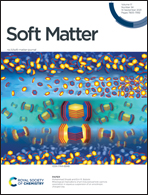Evaporative self-assembly of soft colloidal monolayers: the role of particle softness†
Abstract
We investigate the sessile drop evaporation aided self-assembly of microgel particles by varying their softness. Evaporation of sessile drops containing amphiphilic microgel particles at suitable concentrations results in uniform monolayer deposits that span the entire drop area. At lower concentrations, the deposits are in the form of monolayer coffee rings whose width scales with particle concentration. Using softer microgels synthesised with a lower quantity of crosslinker, we show that the monolayer coffee rings do not form at low particle concentrations. The microgels adsorbed at the interface deform, and the extent of deformation depends on the softness of the microgels as well as their concentration at the interface. Upon complete evaporation of the solvent, the microgel–laden interface is transferred to the substrate. The final deposit shows hexagonal particle arrays where the interparticle separation increases with increasing microgel softness and decreases with particle concentration in the drop. Further insight into the role of microgel softness in the microstructure of the particulate deposits is obtained by measuring the viscoelasticity of the particle–laden interface. Interestingly, the interface loaded with lesser crosslinked microgels exhibits viscoelastic nature even at lower particle concentrations, whereas the higher crosslinked microgels show viscous behaviour.



 Please wait while we load your content...
Please wait while we load your content...